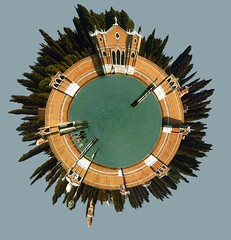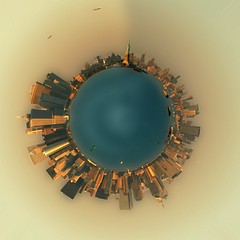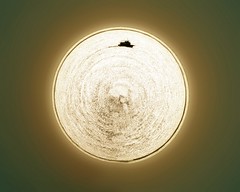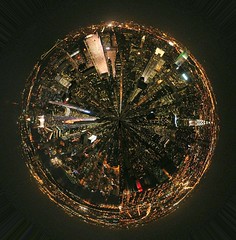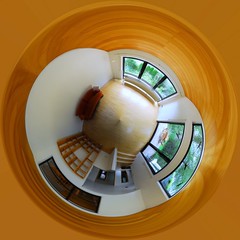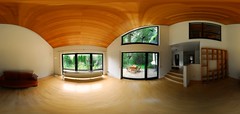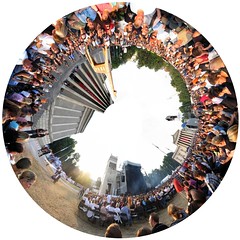Multi Raw Editing Under normal non extreme lighting conditions the modern camera of today will give a well balanced exposure for highlight and shadows, in some circumstances fill flash will also improve things further, but where flash is not practical editing techniques in your photo editing software will enable you to fine tune the exposure short falls in the highlight and shadow regions to produce a well balanced image. But there are times when in say landscape photography to produce a dramatic shot of the lighting manifesting itself in front of you, the only way to capture this is to shoot into the light this in turn presents a problem for your camera as to what exposure it will set in either manual or auto, what will happen is that it will generally be fooled by the brightness of the sky area and underexpose the image leaving the foreground with no detail at all or so little data that even adjusting the exposure slider in the Raw converter will not bring out the shadow detail needed, so a method of capturing both highlight and shadow detail is need to provide the right kinds of exposure to produce workable data in these areas, below is a detailed explanation of how to achieve this using two Raw images of the same subject but at different exposure levels, then using these to produce an image with both areas giving acceptable highlight and shadow detail. The images I have chosen as an example are ones of very high contrast in the sky area and a dark foreground, one that would be impossible to produce using one exposure.
Exposure
First it must be said that lens of high quality are better used for a shot like this as they will control flare to a minimum, set your camera on tripod or brace it so there is no camera movement, set your auto bracket to give, 1st/ auto exposure, 2nd/ minus 2 stops and the 3rd in the sequence plus 2 stops EV, once you have the images then the next step is on your computer.
My Multi Raw file editing techniqueThe images below is part of the AB sequence
Ist shot no compensation

2nd shot minus 2 stops EV

3rd shot plus two stops EV

From the 3 bracketed exposures I have choose images 2 and 3 for my edit, image 2 kept highlights in tact and image 3 with foreground shadow detail present, I did not choose image 1 as highlight detail in the central part had blown, "over exposed"
First for those not that familiar with Photoshop here is a guide to the main tools needed.

Masking and Levels
The first part of the process is to open the chosen images into the Raw converter in this example image 2 is the first, once opened fine adjust the colour balance~shadow areas etc then open the image into PS, now open image three adjust in the raw converter as necessary and open this image into PS, with image three as the active window go to select~select all, edit~copy, deselect and close the image, we now have one active image, go to edit~paste, the copied image is now pasted onto the active image you will notice we now have a copied layer in the layers palette, the next part is to add a layer mask, press Alt on your keyboard and keeping it depressed click the add layer mask icon in the layers palette the image is now masked and only the sky showing, now select a brush from the tools palette [soft brush] and with the foreground colour set to white paint the entire mask out to reveal all the image underneath the mask, now comes the tricky~skilled bit :-) something that requires practice and an idea of what you want the finished "mood" of the image to look like, change your foreground colour to black reduce the brush opacity to 50% and paint back the sky region taking care around the grassy horizon area [we don't want the edit to show here] use the brush as an artist would by varying the opacity to create a balanced overall look and not over processed, if you need to lighten an area just change your foreground colour to white and vica versa to darken, once happy with the edit flatten the image, when done the image should look like this.

Now one thing needs to be done before conversion to monochrome and that is to open the shadow regions and lighten the land area this is done by using levels, press Cntrl J to copy the layer, go to edit~adjustments~levels and pull the middle slider to the left to lighten the land area, all the image will be affected but we are only concerned about the land region, now as described above pres Alt~add layer mask, the levels edit is hidden by the mask, using the brush technique paint back the lighter areas to open the shadows the image should look like this now. Flatten the image.

Conversion to Monochrome
There are many ways to convert a colour image in Photoshop, my favoured method within PS is Channel mixer but i tend now to use a PS plug in called the imagingfactory I find this to be multi functional and more in keeping with conventional BW editing in the wet darkroom era but it does come at a cost, if you only convert the odd image I would use C/M but for the Mono enthusiast
theimagingfactory is very good in this example I have used C/M as i think most newcomers to BW will use it, first press Cntrl J then go to image~ adjustments ~Channel mixer make sure the mono box is checked, now set Red to 100% Green to 0 Blue to 0 reduce the constant slider by approx -6 to darken the sky press ok, Alt add layer mask the image is now all colour use the brush tool to paint back the sky area only so your left with a mono sky and colour land and flatten the image, bring up C/M again but this time set Red to 0 Green to 100% Blue to 0, don't be afraid to use more than 100% green in fact I pulled this to 130%, press ok and flatten, the image should look like this.

Now we need to in increase the contrast I like to use the USM filter for this at high settings, some have said that to high and it is a destructive process but if used with care and selectively applied using the masking technique there is no better way of making the image pop, I regularly print out large images on Fine art paper that look great with no signs its been used other than the deep blacks, crisp whites and the contrast that's needed for most BW images, so Cntrl J filter~unsharp mask set it to this below.

Once you have applied it care must be taken on the pixel edges especially light against dark areas as haloing will occur but there is a way around this, yes the "add layer mask technique" we have been using previously, just press Alt add layer mask and paint back the USM "avoiding" the light to dark pixel edges that way no halo will occur, also use the brush at varying opacities, if full 100% brush opacity is used in the darker regions blocked out shadows will result [completely black areas that look bad especially when printed out] sometimes i use two passes with the filter for even more effect, this is a tricky edit to get used to but once perfected you will use it more and more on your edits it does need handling with care as over cooking it will result in a breakdown of the pixels, used on skies it will bring out detail that was not seen before, to finish the edit I used a small amount of Dodge and Burn to further enhance the dynamics of the image, the finished picture should look like this.

I hope this short tutorial has been of help to you, the same techniques can be used with one raw image just by altering the exposure in the raw converter and opening into PS as many times as needed, this image I have used as an example is of extreme EV [exposure values] and without using two images would have been out of the cameras EV range to capture the tonal ranges needed for this shot and could only be produced and processed in the way described.
------------------------------------------------------------
Dodge and Burn Techniques
For many years wet darkroom workers used the dodge and burn method to lighten and darken images in selected areas of the image, because they where working with light that was from the enlarger and no image to actually see it was a very skilled operation using pre-cut shapes of card plus manipulation of the hands to D&B and took years to perfect, with digital that skill has gone and is much easier to achieve but there is still a skill in getting the desired effect just right, in this tutorial i will show how I Dodge and Burn and why its necessary in digital imaging
Firstly i consider any form of subtraction or addition of light to an image as D&B, there are many ways to achieve the same effect in Photoshop, explained below are three popular ways to do this.
D&B using Selective colour
You will find this dialogue box in PS under image~adjustments~selective colour.

Although all colours can be used, the ones that are best for D&B editing in selective colour are Neutrals and Whites, example one is straight from Raw with no adjustment, all work is carried out on a copied layer ["cntrl J"] shortcut.

In example two I have selected Neutrals from the drop down and will move the black slider to the left to open the darker regions.

Now I will add a layer mask by pressing Alt and clicking the add layer mask icon at the bottom of the layers palette, the effect will be hidden under the mask, all that's needed to do is select a soft brush, foreground colour in the tools palette is set to white and paint the effect back where needed, also by adjusting the brush opacity you can control the amount of painting back anywhere on the image.

Now I will use the above method but this time move the black slider to the right to darken the sky.

As you can see in example four that we have opened the shadows and darkened the sky with smooth transition where applied, the image my look flat as no other editing as been done to boost contrast, this is dealt with in "Contrast increasing using USM"
D&B using Levels command
Levels dialoque box can be found in PS under image~adjustments.

The difference with using Levels as against Selective colour is you have the advantage of using the Histogram, this will allow you to avoid clipping the highlights and shadows, the stack in the histogram box should touch both far left and far right points to avoid clipping, by adjusting the middle Gamma slider, you can slide left to lighten and right to darken, then use the mask and brush to selectively D&B.
[B]D&B using 50% grey and bush tools[/B]
First we must go to the layers palette and open the drop down and click on new layer.

Now in the mode drop on the new layer, select overlay, then click the box as in the example below.

Now select a soft brush, harder if you need to be more precise and set your foreground colour to white to Dodge and black to Burn, also lower the brush opacity to around 20% and paint away where needed, in example below no D&B applied.

In the example below I have lightened the grass and darkened the sky, a great deal of control can be had using this method, vary your opacity but don't go to high, this is one of my favourite methods of D&B works a treat.

Dodge and Burn tools in the tools palette
These tools work in a different way to the above methods, I use these normally at the end of an edit to increase the tonal range and contrast, if heavy D&B is required I would prefer to use the above methods.

The Range when using the Dodge tool must be set to Highlights and Range set to Shadows for the Burn tool, always keep your Exposure setting no higher that 13% and vary this when using the tools to give a visual increase in tonal range, the tools are different because when set to Dodge, the Light pixels are effected and set to Dark, shadow pixels are affected
Here's an example of a partially edited image without D&B used.

And here's the image where I have selectively burnt and dodged the image, notice how the tonal range has increased.

Here's the finished image carefully edited with 50% overlay, D&b tools used plus the other techniques in my other tutorials and a slight tone applied.

So to summaries, four different ways to D&B, two very similar, Selective colour and Levels. 50% Overlay and D&B tools.
Which would I use the most, first for heavy D&B the 50% Overlay, for fine tuning, increasing contrast the D&B tools, the others Selective colour and Levels are very powerful tools in there own right but not a user friendly as the other two.
------------------------------------------------------------






































